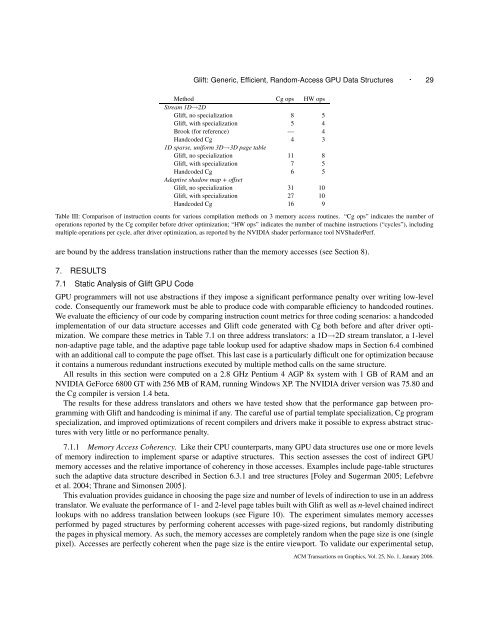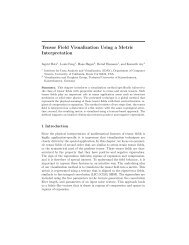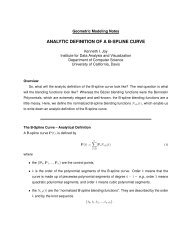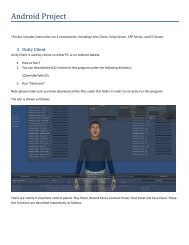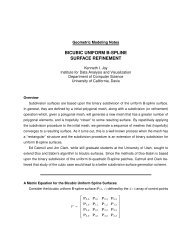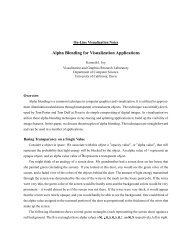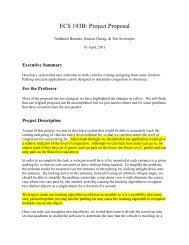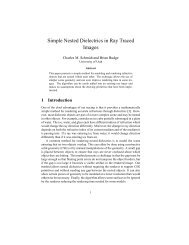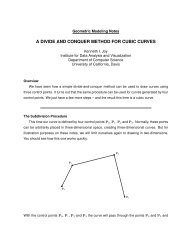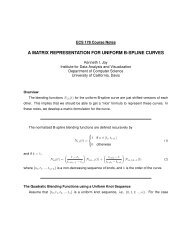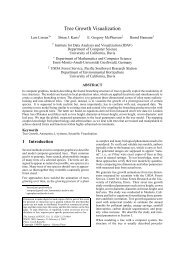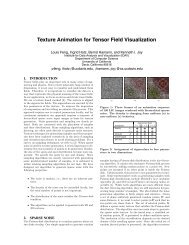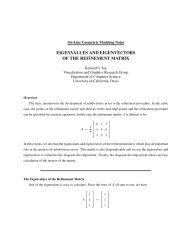Paper - IDAV: Institute for Data Analysis and Visualization
Paper - IDAV: Institute for Data Analysis and Visualization
Paper - IDAV: Institute for Data Analysis and Visualization
You also want an ePaper? Increase the reach of your titles
YUMPU automatically turns print PDFs into web optimized ePapers that Google loves.
Glift: Generic, Efficient, R<strong>and</strong>om-Access GPU <strong>Data</strong> Structures · 29Method Cg ops HW opsStream 1D→2DGlift, no specialization 8 5Glift, with specialization 5 4Brook (<strong>for</strong> reference) — 4H<strong>and</strong>coded Cg 4 31D sparse, uni<strong>for</strong>m 3D→3D page tableGlift, no specialization 11 8Glift, with specialization 7 5H<strong>and</strong>coded Cg 6 5Adaptive shadow map + offsetGlift, no specialization 31 10Glift, with specialization 27 10H<strong>and</strong>coded Cg 16 9Table III: Comparison of instruction counts <strong>for</strong> various compilation methods on 3 memory access routines. “Cg ops” indicates the number ofoperations reported by the Cg compiler be<strong>for</strong>e driver optimization; “HW ops” indicates the number of machine instructions (“cycles”), includingmultiple operations per cycle, after driver optimization, as reported by the NVIDIA shader per<strong>for</strong>mance tool NVShaderPerf.are bound by the address translation instructions rather than the memory accesses (see Section 8).7. RESULTS7.1 Static <strong>Analysis</strong> of Glift GPU CodeGPU programmers will not use abstractions if they impose a significant per<strong>for</strong>mance penalty over writing low-levelcode. Consequently our framework must be able to produce code with comparable efficiency to h<strong>and</strong>coded routines.We evaluate the efficiency of our code by comparing instruction count metrics <strong>for</strong> three coding scenarios: a h<strong>and</strong>codedimplementation of our data structure accesses <strong>and</strong> Glift code generated with Cg both be<strong>for</strong>e <strong>and</strong> after driver optimization.We compare these metrics in Table 7.1 on three address translators: a 1D→2D stream translator, a 1-levelnon-adaptive page table, <strong>and</strong> the adaptive page table lookup used <strong>for</strong> adaptive shadow maps in Section 6.4 combinedwith an additional call to compute the page offset. This last case is a particularly difficult one <strong>for</strong> optimization becauseit contains a numerous redundant instructions executed by multiple method calls on the same structure.All results in this section were computed on a 2.8 GHz Pentium 4 AGP 8x system with 1 GB of RAM <strong>and</strong> anNVIDIA GeForce 6800 GT with 256 MB of RAM, running Windows XP. The NVIDIA driver version was 75.80 <strong>and</strong>the Cg compiler is version 1.4 beta.The results <strong>for</strong> these address translators <strong>and</strong> others we have tested show that the per<strong>for</strong>mance gap between programmingwith Glift <strong>and</strong> h<strong>and</strong>coding is minimal if any. The careful use of partial template specialization, Cg programspecialization, <strong>and</strong> improved optimizations of recent compilers <strong>and</strong> drivers make it possible to express abstract structureswith very little or no per<strong>for</strong>mance penalty.7.1.1 Memory Access Coherency. Like their CPU counterparts, many GPU data structures use one or more levelsof memory indirection to implement sparse or adaptive structures. This section assesses the cost of indirect GPUmemory accesses <strong>and</strong> the relative importance of coherency in those accesses. Examples include page-table structuressuch the adaptive data structure described in Section 6.3.1 <strong>and</strong> tree structures [Foley <strong>and</strong> Sugerman 2005; Lefebvreet al. 2004; Thrane <strong>and</strong> Simonsen 2005].This evaluation provides guidance in choosing the page size <strong>and</strong> number of levels of indirection to use in an addresstranslator. We evaluate the per<strong>for</strong>mance of 1- <strong>and</strong> 2-level page tables built with Glift as well as n-level chained indirectlookups with no address translation between lookups (see Figure 10). The experiment simulates memory accessesper<strong>for</strong>med by paged structures by per<strong>for</strong>ming coherent accesses with page-sized regions, but r<strong>and</strong>omly distributingthe pages in physical memory. As such, the memory accesses are completely r<strong>and</strong>om when the page size is one (singlepixel). Accesses are perfectly coherent when the page size is the entire viewport. To validate our experimental setup,ACM Transactions on Graphics, Vol. 25, No. 1, January 2006.


